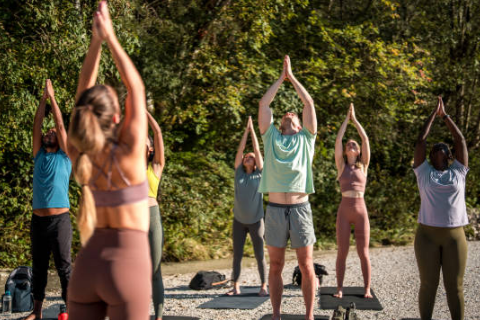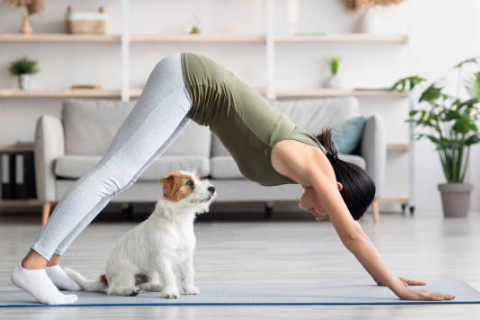Yoga is an ancient practice that combines physical postures, breathing techniques, meditation, and sometimes spiritual elements. The word “yoga” comes from the Sanskrit root “yuj,” meaning “to join” or “to unite” — reflecting the tradition’s goal of uniting the individual soul with the universe. Today, people use yoga to connect body and mind while improving health and fitness.
Yoga is accessible to all body types and fitness levels. You don’t need to be extremely flexible to start—yoga helps develop flexibility and range of motion and is ideal for those wanting to improve everyday movements.
With many styles of yoga available, each with its own focus and intensity, it can be helpful to explore a few before committing—especially if your local studio offers multiple classes. Research shows that yoga offers numerous health benefits, but practicing it safely is essential.

Popular Yoga Styles
Here’s a quick look at 13 of the most common yoga types:
-
Acro Yoga: Partner-based yoga where one person supports the other in poses like Downward Dog. Often done in pairs to build communication and trust.
-
Aerial Yoga: Uses a suspended silk hammock to support traditional yoga poses and inversions—great for those who want to try upside-down poses with assistance.
-
Ashtanga Yoga: A dynamic, physically demanding style involving six specific poses practiced in sequence. You generally need to master one before progressing to the next.
-
Bikram (Hot) Yoga: Done in a room heated to 105°F (40°C) with 40% humidity. Classes typically involve a fixed set of 26 poses performed in order over 90 minutes, plus breathing exercises.
-
Hatha Yoga: A catch-all term that often suits beginners. Hatha classes include postures, breathing exercises, and meditation, though some sessions can still be challenging.
-
Iyengar Yoga: Known for its use of props (chairs, blocks, straps, blankets), making it ideal for beginners or older adults needing extra support.
-
Kundalini Yoga: Combines poses, breath work, meditation, chanting, and sometimes singing. Many wear white clothing to symbolize clearing negative energy.
-
Power Yoga: A fast-paced, fitness-oriented form of yoga focused on strength and stamina—great if you prefer a workout over spiritual practice.
-
Prenatal Yoga: Designed for pregnant individuals to relieve common pregnancy pains like backaches.
-
Restorative Yoga: A gentle practice that uses props to support deep, relaxing poses held for several minutes to help release stress.
-
Sivananda Yoga: A basic style rooted in Hatha yoga. Classes start with Savasana (corpse pose), followed by breathing exercises, Sun Salutations, and a series of 12 poses.
-
Vinyasa (Flow) Yoga: One of the most popular styles—poses flow with the breath in a continuous, rhythmic sequence. It’s accessible for beginners.
-
Yin Yoga: Slow-paced, with poses held for anywhere from 1 to 5 minutes. It targets deeper connective tissues like ligaments and fascia in areas such as hips, thighs, and lower back.
Benefits of Yoga
Yoga offers a wide range of health benefits, especially with consistent practice:
Flexibility & Balance
Combining stretching and breath control, yoga increases your range of motion and improves balance. This often translates to better form and performance in other sports and daily activities.
Pain Relief
Practicing yoga with proper technique can reduce chronic lower back pain. Some evidence also suggests it may help decrease the frequency and duration of tension headaches.
Mental Health
Yoga has been shown to reduce symptoms of depression, stress, and anxiety. Regular practice often leads to better mood and emotional well-being.

Weight Management
Studies have found that overweight or obese women who practiced yoga twice weekly for 12 weeks experienced greater weight loss—and significant improvements in mindfulness, self-compassion, and stress management—compared to those in a cooking and nutrition program. Six months later, they were more satisfied and more likely to stick with the practice.
Getting Started with Yoga
You don’t need much to begin practicing: a mat is helpful for stability, comfort, and defining your space. If you don’t have one, many studios provide mats to rent or borrow.
Wear comfortable, breathable clothes that allow movement and absorb sweat. Bring water and a towel—particularly for hot yoga or Vinyasa flow classes.
If you’re new to yoga, start with beginner classes. Instructors will guide you through basic poses and offer modifications to suit your level. More advanced classes can move quickly and include complex poses.
Make sure you feel welcome and comfortable in the studio you choose—where asking questions and learning is encouraged. If you’re practicing at home, online classes can help—but without an instructor present, be attentive to your alignment.
Some studios have behavioral norms: removing shoes, silencing phones, minimal talking, and respecting meditation or chanting traditions (like sankalpa). Be mindful of these customs if you join in-studio classes.
Safety Tips for Yoga Practice
Yoga is generally safe and low-impact, but injuries can occur if done incorrectly or pushed too far. Common issues include strains, sprains, or even ligament injuries. Here’s how to stay safe and get the most benefit:
-
Check with your doctor before starting if you have health conditions or concerns.
-
Choose the right style for your fitness level and health goals.
-
Take beginner classes with certified instructors who can correct your form and protect you from strain.
-
Listen to your body—never force a pose. If it hurts, ease out and rest.
-
Stay hydrated, especially during hot or vigorous classes.

